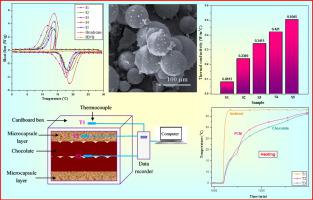Journal of Industrial and Engineering Chemistry ( IF 5.9 ) Pub Date : 2021-07-02 , DOI: 10.1016/j.jiec.2021.06.029 Sumit Parvate 1 , Jitendra Singh 1 , Jagadeeswara Reddy Vennapusa 1 , Prakhar Dixit 1 , Sujay Chattopadhyay 1

|
A novel kind of functionalized copper nanoparticles (CuNPs) interlocked polydivinylbenzene (PDVB) microcapsules containing hexadecane as phase change material (PCM) was synthesized targeting thermal buffering application in food packaging. Fourier transform infrared spectroscopy (FT-IR) and transmission electron microscopy (TEM) characterizations confirmed the successful functionalization of CuNPs and their existence in the PDVB shell. Scanning electron microscopy (SEM) results indicated that produced microcapsules exhibited well-defined core–shell microstructure with spherical morphology, and their compositions and chemical structures were confirmed by a series of spectroscopic characterizations. Atomic force microscopy (AFM) results showed that average and mean square roughness is higher in CuNPs/microPCMs than bare microcapsules. Differential scanning calorimetry (DSC) analysis confirmed that microPCM with 1.0% CuNPs achieved a maximum melting enthalpy of 132 J/g with an encapsulation ratio of 60.5% and could maintain it even after 100 melting-freezing cycles. The thermal conductivity was significantly increased by 319.5% as compared with that of bare microcapsules. Most importantly, optimized microcapsules provided an excellent thermal buffering effect of more than 6.5 h for the 240 g of chocolate to raise its temperature from 5 °C to 35 °C, confirming great potential in food packaging application.
中文翻译:

铜纳米颗粒互锁相变微胶囊用于包装应用中的热缓冲
针对食品包装中的热缓冲应用,合成了一种含有十六烷作为相变材料 (PCM) 的新型功能化铜纳米粒子 (CuNPs) 互锁聚二乙烯基苯 (PDVB) 微胶囊。傅里叶变换红外光谱 (FT-IR) 和透射电子显微镜 (TEM) 表征证实了 CuNPs 的成功功能化及其在 PDVB 壳中的存在。扫描电子显微镜(SEM)结果表明,制备的微胶囊具有明确的核壳微观结构,具有球形形态,其组成和化学结构通过一系列光谱表征得到证实。原子力显微镜 (AFM) 结果表明,CuNPs/microPCMs 的平均和均方粗糙度高于裸微胶囊。差示扫描量热法 (DSC) 分析证实,含有 1.0% CuNPs 的 microPCM 在 60.5% 的包封率下实现了 132 J/g 的最大熔化焓,并且即使在 100 次熔化-冷冻循环后仍能保持该焓。与裸微胶囊相比,热导率显着提高了 319.5%。最重要的是,优化的微胶囊为 240 克巧克力提供了超过 6.5 小时的出色热缓冲效果,将其温度从 5°C 提高到 35°C,证实了其在食品包装应用中的巨大潜力。与裸微胶囊相比,热导率显着提高了 319.5%。最重要的是,优化的微胶囊为 240 克巧克力提供了超过 6.5 小时的出色热缓冲效果,将其温度从 5°C 提高到 35°C,证实了其在食品包装应用中的巨大潜力。与裸微胶囊相比,热导率显着提高了 319.5%。最重要的是,优化的微胶囊为 240 克巧克力提供了超过 6.5 小时的出色热缓冲效果,将其温度从 5°C 提高到 35°C,证实了其在食品包装应用中的巨大潜力。











































 京公网安备 11010802027423号
京公网安备 11010802027423号